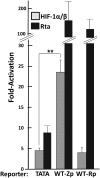Hypoxia-inducible factor-1α plays roles in Epstein-Barr virus's natural life cycle and tumorigenesis by inducing lytic infection through direct binding to the immediate-early BZLF1 gene promoter
- PMID: 28617871
- PMCID: PMC5487075
- DOI: 10.1371/journal.ppat.1006404
Hypoxia-inducible factor-1α plays roles in Epstein-Barr virus's natural life cycle and tumorigenesis by inducing lytic infection through direct binding to the immediate-early BZLF1 gene promoter
Abstract
When confronted with poor oxygenation, cells adapt by activating survival signaling pathways, including the oxygen-sensitive transcriptional regulators called hypoxia-inducible factor alphas (HIF-αs). We report here that HIF-1α also regulates the life cycle of Epstein-Barr virus (EBV). Incubation of EBV-positive gastric carcinoma AGS-Akata and SNU-719 and Burkitt lymphoma Sal and KemIII cell lines with a prolyl hydroxylase inhibitor, L-mimosine or deferoxamine, or the NEDDylation inhibitor MLN4924 promoted rapid and sustained accumulation of both HIF-1α and lytic EBV antigens. ShRNA knockdown of HIF-1α significantly reduced deferoxamine-mediated lytic reactivation. HIF-1α directly bound the promoter of the EBV primary latent-lytic switch BZLF1 gene, Zp, activating transcription via a consensus hypoxia-response element (HRE) located at nt -83 through -76 relative to the transcription initiation site. HIF-1α did not activate transcription from the other EBV immediate-early gene, BRLF1. Importantly, expression of HIF-1α induced EBV lytic-gene expression in cells harboring wild-type EBV, but not in cells infected with variants containing base-pair substitution mutations within this HRE. Human oral keratinocyte (NOK) and gingival epithelial (hGET) cells induced to differentiate by incubation with either methyl cellulose or growth in organotypic culture accumulated both HIF-1α and Blimp-1α, another cellular factor implicated in lytic reactivation. HIF-1α activity also accumulated along with Blimp-1α during B-cell differentiation into plasma cells. Furthermore, most BZLF1-expressing cells observed in lymphomas induced by EBV in NSG mice with a humanized immune system were located distal to blood vessels in hypoxic regions of the tumors. Thus, we conclude that HIF-1α plays central roles in both EBV's natural life cycle and EBV-associated tumorigenesis. We propose that drugs that induce HIF-1α protein accumulation are good candidates for development of a lytic-induction therapy for treating some EBV-associated malignancies.
Conflict of interest statement
The authors have declared that no competing interests exist.
Figures













Similar articles
-
Reactivation of Epstein-Barr Virus by HIF-1α Requires p53.J Virol. 2020 Aug 31;94(18):e00722-20. doi: 10.1128/JVI.00722-20. Print 2020 Aug 31. J Virol. 2020. PMID: 32641480 Free PMC article.
-
Cellular differentiation regulator BLIMP1 induces Epstein-Barr virus lytic reactivation in epithelial and B cells by activating transcription from both the R and Z promoters.J Virol. 2015 Feb;89(3):1731-43. doi: 10.1128/JVI.02781-14. Epub 2014 Nov 19. J Virol. 2015. PMID: 25410866 Free PMC article.
-
The B-cell specific transcription factor, Oct-2, promotes Epstein-Barr virus latency by inhibiting the viral immediate-early protein, BZLF1.PLoS Pathog. 2012 Feb;8(2):e1002516. doi: 10.1371/journal.ppat.1002516. Epub 2012 Feb 9. PLoS Pathog. 2012. PMID: 22346751 Free PMC article.
-
Switching of EBV cycles between latent and lytic states.Rev Med Virol. 2014 May;24(3):142-53. doi: 10.1002/rmv.1780. Epub 2013 Dec 11. Rev Med Virol. 2014. PMID: 24339346 Review.
-
Regulation of the latent-lytic switch in Epstein-Barr virus.Semin Cancer Biol. 2014 Jun;26:60-8. doi: 10.1016/j.semcancer.2014.01.002. Epub 2014 Jan 20. Semin Cancer Biol. 2014. PMID: 24457012 Free PMC article. Review.
Cited by
-
A distinct isoform of lymphoid enhancer binding factor 1 (LEF1) epigenetically restricts EBV reactivation to maintain viral latency.PLoS Pathog. 2023 Dec 19;19(12):e1011873. doi: 10.1371/journal.ppat.1011873. eCollection 2023 Dec. PLoS Pathog. 2023. PMID: 38113273 Free PMC article.
-
Hypoxia triggers the outbreak of infectious spleen and kidney necrosis virus disease through viral hypoxia response elements.Virulence. 2022 Dec;13(1):714-726. doi: 10.1080/21505594.2022.2065950. Virulence. 2022. PMID: 35465839 Free PMC article.
-
Nascent Transcriptomics Reveal Cellular Prolytic Factors Upregulated Upstream of the Latent-to-Lytic Switch Protein of Epstein-Barr Virus.J Virol. 2020 Mar 17;94(7):e01966-19. doi: 10.1128/JVI.01966-19. Print 2020 Mar 17. J Virol. 2020. PMID: 31941784 Free PMC article.
-
Identification and Cloning of a New Western Epstein-Barr Virus Strain That Efficiently Replicates in Primary B Cells.J Virol. 2020 May 4;94(10):e01918-19. doi: 10.1128/JVI.01918-19. Print 2020 May 4. J Virol. 2020. PMID: 32102884 Free PMC article.
-
Epstein-Barr Virus Infection of Oral Squamous Cells.Microorganisms. 2020 Mar 16;8(3):419. doi: 10.3390/microorganisms8030419. Microorganisms. 2020. PMID: 32188127 Free PMC article.
References
-
- Longnecker RM, Kieff E, Cohen JI. Epstein-Barr virus Fields Virology. 6th edition Lippincott, Williams, and Willams; 2013.
-
- Thorley-Lawson DA. EBV Persistence—Introducing the Virus. Curr Top Microbiol Immunol. 2015;390: 151–209. doi: 10.1007/978-3-319-22822-8_8 - DOI - PMC - PubMed
-
- Kang M-S, Kieff E. Epstein-Barr virus latent genes. Exp Mol Med. 2015;47: e131 doi: 10.1038/emm.2014.84 - DOI - PMC - PubMed
-
- Kutok JL, Wang F. Spectrum of Epstein-Barr virus-associated diseases. Annu Rev Pathol. 2006;1: 375–404. doi: 10.1146/annurev.pathol.1.110304.100209 - DOI - PubMed
-
- Rickinson AB. Co-infections, inflammation and oncogenesis: future directions for EBV research. Semin Cancer Biol. 2014;26: 99–115. doi: 10.1016/j.semcancer.2014.04.004 - DOI - PubMed
MeSH terms
Substances
Grants and funding
LinkOut - more resources
Full Text Sources
Other Literature Sources
Medical
Research Materials

